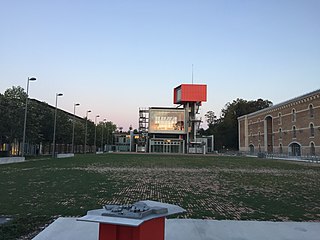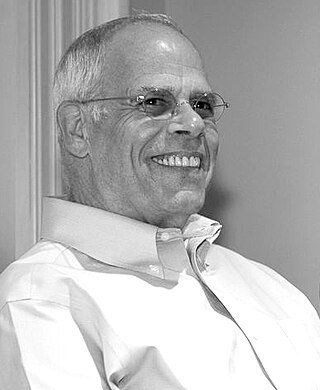Related Research Articles

Port-au-Prince is the capital and most populous city of Haiti. The city's population was estimated at 1,200,000 in 2022 with the metropolitan area estimated at a population of 2,618,894. The metropolitan area is defined by the IHSI as including the communes of Port-au-Prince, Delmas, Cite Soleil, Tabarre, Carrefour, and Pétion-Ville.

Amiens is a city and commune in northern France, located 120 km (75 mi) north of Paris and 100 km (62 mi) south-west of Lille. It is the capital of the Somme department in the region of Hauts-de-France and had a population of 135,429, as of 2021. A central landmark of the city is Amiens Cathedral, the largest Gothic cathedral in France. Amiens also has one of the largest university hospitals in France, with a capacity of 1,200 beds. The author Jules Verne lived in Amiens from 1871 until his death in 1905, and served on the city council for 15 years. Amiens is the birthplace of French president Emmanuel Macron.

Cryptosporidiosis, sometimes informally called crypto, is a parasitic disease caused by Cryptosporidium, a genus of protozoan parasites in the phylum Apicomplexa. It affects the distal small intestine and can affect the respiratory tract in both immunocompetent and immunocompromised individuals, resulting in watery diarrhea with or without an unexplained cough. In immunosuppressed individuals, the symptoms are particularly severe and can be fatal. It is primarily spread through the fecal-oral route, often through contaminated water; recent evidence suggests that it can also be transmitted via fomites contaminated with respiratory secretions.

The State University of Haiti is one of Haiti's most prestigious institutions of higher education. It is located in Port-au-Prince.

The University of Picardy Jules Verne is a public university located in the former Picardy region of France.
Victoire Jean-Baptiste (1861–1923), known as "La Belle Victoire", was a politically influential Haitian woman, mistress to President Florvil Hyppolite and highly influential during his term of office. She had previously been the mistress of Hyppolite's successor, Tirésias Simon Sam, and was granted immunity by him after the death of Florvil Hyppolite.
Guy Alexandre was a Haitian sociologist, diplomat, and professor.
Lucienne Heurtelou was a Haitian diplomat, women's rights advocate, and author. She was the First Lady of Haiti from 1946 to 1950 as the wife of Haitian President Dumarsais Estimé.

The International University of Rabat or UIR is a semi-public university founded in 2010 in Morocco. It delivers double-degrees, in collaboration with foreign universities, in law, engineering, aeronautics, energy engineering, architecture, business management and political sciences.

The 2016 CFU Club Championship was the 18th edition of CFU Club Championship, the annual international club football competition in the Caribbean region, held amongst clubs whose football associations are affiliated with the Caribbean Football Union (CFU). The top three teams in the tournament qualified for the 2016–17 CONCACAF Champions League. Central were the defending champions, having won the 2015 CFU Club Championship, and successfully defended their title, defeating fellow Trinidadian side W Connection in the final for the second straight year.
Quisqueya University, founded in 1988, is a private Haitian university located in Port-au-Prince. The coordinator of the university's establishment and its first rector, from 1990 to 1995, was Jacques-Édouard Alexis who became Prime Minister of Haiti in 1999. The institution is considered to be Haiti's leading private university.
Odette Roy Fombrun was a Haitian writer and intellectual.
Émile Ollivier was a Haitian-born educator and writer living in Quebec, Canada. He was considered one of the most important Haitian writers of his time.

Peter Daniel Alexander Jacobs is a Canadian landscape architect specializing in the conservation and development of rural and northern landscapes and in urban landscape design. He is Emeritus professor of the School of Planning and Landscape Architecture of the Universite de Montreal, Emeritus Chair of the Commission on Environmental Planning of the International Union for the conservation of nature (IUCN), Past President of the Canadian Society of Landscape Architects (CSLA), Chair of the Kativik Environmental Quality Commission and a Member of the Royal Canadian Academy of the Arts.
COUPERIN is an academic consortium in France. Formed in 1999, it includes more than 250 universities, research organizations, Grandes écoles (schools), COMUE, and others. The consortium negotiates with publishers the prices and conditions of access to scientific publications and other digital resources for the benefit of its members. It promotes open science, particularly with regard to scientific publications, both nationally and internationally. It is headquartered in Paris.
Monferrier Dorval, born in Grande-Saline, town of the Artibonite department on June 10, 1956, was the president of the Ordre des Avocats de Port-au-Prince, assassinated in his private residence on August 28, 2020.
Françoise Vimeux is a French climatologist. She is Director of Scientific Research at the Institut de recherche pour le développement (IRD), works at the Laboratoire des sciences du climat et de l'environnement (LSCE) and at the Laboratoire HydroSciences Montpellier (HSM).
Water stress is increasingly affecting urbanization. Water stress arises through slum development, anarchic construction, water scarcity, the absence of financial structures, the absence of basic structures, the absence of infrastructure such as roads, bridges, sidewalks, signs, markets, schools, etc., can sometimes hinder the productivity of certain cities. Unfortunately, this phenomenon affects even the largest cities in the world; in 2018, 300,000 were recorded in the world, housing around 40% of the world's urban population.
In Haiti, the disruption of the water cycle remains a major environmental challenge, affecting biodiversity and the daily lives of the country's inhabitants. The problem has multiple causes, including the proliferation of shantytowns and the absence of a comprehensive urban development policy. Global warming is one of the main causes of this problem, faced with one of the most disastrous economic, social and political situations on the planet, Haiti is unable to implement an urban development policy. On the other hand, deforestation encourages natural disasters. Thus, the disruption of the water cycle remains a lasting threat to the country's development.
References
- ↑ "Why Clean Water|Haiti Water" . Retrieved 2023-09-28.
- 1 2 "Document d'orientation stratégique pour l'assainissement en Haïti. Direction Nationale de l'Eau Potable et de L'Assainissement (DINEPA). Révision mars 2014" (PDF).
- 1 2 "Haïti-Assainissement : La gestion des excréta, un immense problème qui semble être négligé (II) - Haiti | ReliefWeb". reliefweb.int. 2015-03-02. Retrieved 2023-09-28.
- ↑ "population totals". Haitian Institute of Statistics. L'Institut Haïtien de Statistique et d'Informatique. Retrieved 2023-09-28.
- 1 2 Bras, A.; Berdier, C.; Emmanuel, E.; Zimmerman, M. (November 2009). "Problems and current practices of solid waste management in Port-au-Prince (Haiti)". Waste Management. 29 (11): 2907–2909. Bibcode:2009WaMan..29.2907B. doi:10.1016/j.wasman.2009.07.015. PMID 19709869.
- ↑ Laboratoire de Qualité de l’Eau et de l’Environnement, Université Quisqueya, BP 796, Port-au-Prince, Haïti; Balthazard-Accou, Ketty; Laboratoire de parasitologie et mycologie médicales, Faculté de médecine et CHU d’Amiens, Université de Picardie Jules Verne, 80054 Amiens, France; Emmanuel, Evens; Laboratoire de Qualité de l’Eau et de l’Environnement, Université Quisqueya, BP 796, Port-au-Prince, Haïti; Agnamey, Patrice; Laboratoire de parasitologie et mycologie médicales, Faculté de médecine et CHU d’Amiens, Université de Picardie Jules Verne, 80054 Amiens, France; Brasseur, Philippe; Unité Mixte de Recherche 198, Institut de Recherche pour le Développement (IRD), Centre de Hann, Dakar, Sénégal; Lilite, Obicson; Centre d’Applications en Télédétection et en systèmes d’Informations Géographiques, Université Quisqueya, BP 796, Port-au-Prince, Haïti; Totet, Anne; Laboratoire de parasitologie et mycologie médicales, Faculté de médecine et CHU d’Amiens, Université de Picardie Jules Verne, 80054 Amiens, France; Raccurt, Christian P.; Laboratoire de parasitologie et mycologie médicales, Faculté de médecine et CHU d’Amiens, Université de Picardie Jules Verne, 80054 Amiens, France (2009-03-31). "Presence of Cryptosporidium Oocysts and Giardia Cysts in the Surface Water and Groundwater in the City of Cayes, Haiti". Aqua-LAC. 1 (1): 63–71. doi: 10.29104/phi-aqualac/2009-v1-1-06 .
{{cite journal}}: CS1 maint: multiple names: authors list (link) CS1 maint: numeric names: authors list (link) - 1 2 Brasseur, Philippe; Agnamey, Patrice; Emmanuel, Evens; Pape, Jean W.; Vaillant, Michel; Raccurt, Christian P. (2011-01-31). "Cryptosporidium Contamination of Surface and Water Supplies in Haiti". Archives of Environmental & Occupational Health. 66 (1): 12–17. Bibcode:2011ArEOH..66...12B. doi:10.1080/19338244.2010.506492. ISSN 1933-8244. PMID 21337181. S2CID 45743351.
- ↑ Université Quisqueya, Laboratoire de Qualité de l’Eau et de l’Environnement. Association Haïtienne Femmes, Science et Technologie. Haití; Balthazard-Accou, Ketty; Emmanuel, Evens; Université Quisqueya, Laboratoire de Qualité de l’Eau et de l’Environnement. Haití; Diouf, Momar; Unité de Biostatistique, Direction de la Recherche Clinique et de l’Innovation. Francia; Agnamey, Patrice; Université de Picardie Jules Verne. Francia (2017-03-31). "Contaminación microbiológica de las aguas subterráneas por los Oocitos de Cryptosporidium en Haití. Evaluación de los riesgos para la salud de la población". Aqua-LAC. 9 (1): 51–63. doi: 10.29104/phi-aqualac/2017-v9-1-05 .
{{cite journal}}: CS1 maint: multiple names: authors list (link) - ↑ "Gavi, the Vaccine Alliance". www.gavi.org. Retrieved 2023-09-28.
- ↑ "Emergency Appeal: Cholera Resurgence in Haiti, 9 November 2022 - PAHO/WHO | Pan American Health Organization". www.paho.org. Retrieved 2023-09-28.